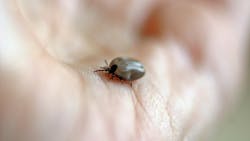Early point-of-care testing needed with Lyme disease on the rise nationwide
As America approaches the tail end of the COVID-19 pandemic, a quiet epidemic has emerged that has the potential to affect as many as 476,000 citizens before the year is out: Lyme disease, which is being identified in record numbers throughout the country, reported Quidel.
Researchers at such institutions as Johns Hopkins, Colorado State University and SUNY Upstate Medical University in Syracuse are all reporting an increased spread of Lyme disease. And they are finding it not only in the woodlands of New England and other forested regions as typically expected but in unexpected numbers on the beaches in Northern California, throughout the southwest and southeast and other parts of the country where reported cases are on the rise.
One suspected reason for the uptick is the pandemic itself, which drove people to spend more time walking outdoors and now, with restrictions being lifted, are seeing these people hitting the road for open-air destinations throughout the country. To complicate matters, this past winter was one of the warmest on record; and lingering summer heat added weeks of outdoor activity to animals that carry ticks and which thrive in hot, humid conditions. Pests.org, which produces an annual 2021 Tick Forecast, projects that “most states will experience the warmer, wetter conditions that drive tick populations—and the prospect of tick-borne diseases—skyward.”
As the prevalence and fear of Lyme disease intensifies, one thing that all experts agree on is the need for testing immediately if there are signs that someone may have contracted Lyme disease. These signs may include fever, headache, fatigue, joint pain, weakness in the limbs and often a characteristic skin rash with a bull's-eye pattern.
The Sofia 2 Lyme FIA test by Quidel provides the patient and physician with indicative results within 15 minutes, as opposed to days, which has historically been the norm (and during which time organisms can spread and become systemic). It can be performed in the privacy of a doctor’s office, local clinic or even by a nurse at a children’s summer camp; and it is the only test that can get results from a simple finger prick of blood.
One fear that some researchers have is that some people experiencing symptoms of Lyme may have been reluctant to seek medical care over the past year, given their concerns about exposure to COVID at the doctor’s office or clinic. This could result in cases going undiagnosed and untreated, which makes Lyme disease much more serious and harder to treat later on.
“As with all afflictions, the key is catching it early so effective treatment can begin as soon as possible,” said Dr. Tilghman. “Lyme disease can affect people of any age or gender. People should not hesitate to get tested, and physicians should have their radar up for signs of Lyme disease in their patients. With the general population’s increased awareness of Lyme disease, along with increased clinical awareness in the importance of early testing for tick-borne infections, later stages of Lyme disease and the life-threatening effects that accompany them should never happen.”
